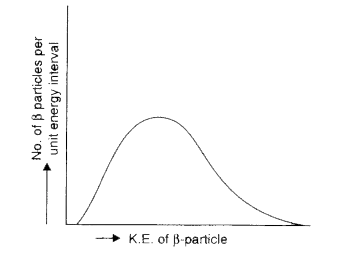Why is the energy distribution of β rays continuous?
To understand why the energy distribution of beta rays is continuous, we can break down the explanation into several steps:
1. Understanding Beta Decay:
- Beta decay is a process in which a beta particle (which can be an electron or positron) is emitted from a nucleus. This process can be represented as:
A→B+β+¯ν
where A is the parent nucleus, B is the daughter nucleus, β is the beta particle, and ¯ν is the anti-neutrino.
2. Emission of Anti-neutrino:
- During beta decay, not only is the beta particle emitted, but also an anti-neutrino. The presence of this additional particle is crucial for the energy distribution.
3. Conservation of Energy:
- The total energy before and after the decay must be conserved. The energy released in the decay process is shared between the beta particle and the anti-neutrino.
4. Energy Sharing:
- Since the total energy is a constant value, the energy can be distributed between the beta particle and the anti-neutrino in various ways. This means that the beta particle can have a range of energies depending on how much energy is taken by the anti-neutrino.
5. Continuous Energy Distribution:
- Because the energy can be shared in different proportions between the beta particle and the anti-neutrino, the beta particle can have a continuous spectrum of energies. This results in a continuous energy distribution for beta rays.
6. Conclusion:
- Therefore, the energy distribution of beta rays is continuous due to the emission of the anti-neutrino, which allows for the sharing of energy between the two emitted particles.
- Beta decay is a process in which a beta particle (which can be an electron or positron) is emitted from a nucleus. This process can be represented as:
A→B+β+¯ν
where A is the parent nucleus, B is the daughter nucleus, β is the beta particle, and ¯ν is the anti-neutrino.
- During beta decay, not only is the beta particle emitted, but also an anti-neutrino. The presence of this additional particle is crucial for the energy distribution.
- The total energy before and after the decay must be conserved. The energy released in the decay process is shared between the beta particle and the anti-neutrino.
- Since the total energy is a constant value, the energy can be distributed between the beta particle and the anti-neutrino in various ways. This means that the beta particle can have a range of energies depending on how much energy is taken by the anti-neutrino.
- Because the energy can be shared in different proportions between the beta particle and the anti-neutrino, the beta particle can have a continuous spectrum of energies. This results in a continuous energy distribution for beta rays.
- Therefore, the energy distribution of beta rays is continuous due to the emission of the anti-neutrino, which allows for the sharing of energy between the two emitted particles.
Topper's Solved these Questions
- ATOMS AND NUCLEIBOOK - PRADEEPCHAPTER - ATOMS AND NUCLEIEXERCISE - (III) Questions short 20
1 Videos
- ATOMS AND NUCLEIBOOK - PRADEEPCHAPTER - ATOMS AND NUCLEIEXERCISE - (III) Questions short 21
1 Videos
- ATOMS AND NUCLEIBOOK - PRADEEPCHAPTER - ATOMS AND NUCLEIEXERCISE - (I) Questions short 12
1 Videos
- COMMUNICATION SYSTEMSBOOK - PRADEEPCHAPTER - COMMUNICATION SYSTEMSEXERCISE - MODEL TEST PAPER-2
9 Videos
Similar Questions
Every metal has a definite work function. Why do all photoelectrons not come out with the same energy if incident radiatio is monochromatic ? Why is there an energy distribution of photoelectrons ?
View SolutionWhat is beta decay? Write an equation to represent β−andβ+ decay.
Explain the energy distribution curve is β decay.
View SolutionConsider the decay of a free neutron at rest: n⊤+e− Show that the tow-body dacay of this type must necessarily give an electron of fixed energy and, therefore, cannot for the observed continous energy distribution in the β-decay of a neutron or a nucleus.

View Solution____ is a graphical presentation of a frequency distribution of a continuous series . (Histogram / Polygon)
View SolutionDraw the graph showing distribution of kinetic energy of electrons emitted during beta decay.
View SolutionWhat is the value of charge and mass of beta particles ? Why is beta particle energy spectrum continuous ?
View SolutionDraw the graph showing distribution of kinetic energy of electrons emitted during beta decay.
View SolutionWhy is the Public Distribution System criticised?
View SolutionColumn-IColumn-II(A)beta-rays(P)Continous energy distribution with dark lines in between(B)y-rays(Q)Continuous energy distribution with sharp peacks in between(C)Absorption spectrum of Hydrogen(R)Continuous energy distribution(D)X-rays(S)Discrete energy distribution
View Solution(a) Draw the energy level diagram showing the emission of β-particles followed by γ-rays by a 6027Co nucleus.
(b) Plot the distribution of kinetic energy of β-particles and state why the energy spectrum is continuous.
View Solution
